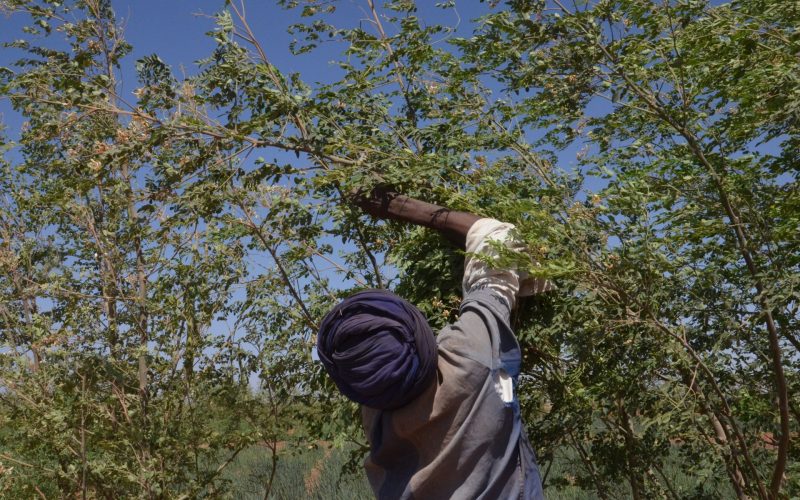Recommendations
- Barriers to accessing and disbursing climate finance can be overcome through the combined
efforts of both recipients and donors. While the reforms required within recipients have been
explored, more considered attention is required for donor reforms. - Donors should undertake comprehensive internal reviews to identify and implement
improvements to their processes; provide institutional support, as well as guidance and
improved assessment methodologies; and consolidate platforms to offer available climate
finance. - Jointly, donor and recipient countries should work towards achieving international agreement
on and acceptance of what is considered to qualify as climate finance.
Executive summary
To date, only a fraction of climate finance has benefitted sub-Saharan Africa. The availability of finance is not commensurate with current needs and resource deployment has a tendency to be more donor-centric than recipient-focused. This policy briefing explores this issue, focusing on three common barriers to access, namely recipient country capacity, needs assessment and knowledge deficiencies. It argues that the focus has tended to be on reforms within recipient countries, but that donor positions contribute to the root causes of such challenges. It concludes that substantive reform requires the combined efforts of both recipients and donors and recommends various measures within and among donors that would facilitate access to climate finance by sub-Saharan African countries.
Introduction
Twentieth-century American political philosophers Arthur(s) Schlesinger (senior and junior) proposed and refined their ‘cyclical theory’ to explain the regular alternation between liberalist and conservative values in American politics and society during that fraught epoch.1Arthur Schlesinger Snr., Paths to the Present (New York: The Macmillan Company, 1949) and Arthur Schlesinger Jnr., The Cycles of American History (Boston: Houghton Mifflin, 1986). In similar fashion, the tides of international climate change finance ebb and flow, driven by the winds of global realpolitik and economics. The UN Framework Convention on Climate Change’s (UNFCCC) Standing Committee on Finance (SCF) and the Organisation for Economic Co-operation and Development (OECD) have both recently discerned that the availability of climate finance has significantly improved,2UN Framework Convention on Climate Change, Summary and Recommendations by the Standing Committee on Finance on the 2018 Biennial Assessment and Overview of Climate Finance Flows, 7, https://unfccc.int/sites/default/files/resource/51904%20-%20UNFCCC%20BA%202018%20-%20Summary%20Final.pdf; Organisation for Economic Co-operation and Development, Climate Finance Provided and Mobilised by Developed Countries in 2013–2017 (Paris: OECD Publishing, 2019), 8, https://www.oecd-ilibrary.org/environment/climate-finance-provided-and-mobilised-by-developed-countries-in-2013-17_39faf4a7-en. partly owing to elevated investment in private sector renewable energy.3See UNFCCC, 2018 Biennial Assessment and Overview of Climate Finance Flows – Technical Report, https://unfccc.int/sites/ default/files/resource/2018%20BA%20Technical%20Report%20Final%20Feb%202019.pdf; Padraig Oliver et al., Global Climate Finance: An Updated View 2018, Climate Policy Initiative, November 2018, https://climatepolicyinitiative.org/wp-content/ uploads/2018/11/Global-Climate-Finance-_-An-Updated-View-2018.pdf; John Ndiso, “World Bank, AfDB Commit $47 bln to African Climate Finance”, Reuters, March 14, 2019, https://af.reuters.com/article/investingNews/idAFKCN1QV1Z7-OZABS. See also OECD, Climate Finance Provided, 10. Yet only a fraction of the resource has, hitherto, benefitted sub-Saharan Africa,4Chizurum Chikwendu, “Closing the Gap in Climate Finance in Sub Saharan Africa”, Nigeria Financial – Development and Finance, September 26, 2017, http://www.financialnigeria.com/closing-the-gap-in-climate-finance-in-sub-saharan-africa-sustainable-906. html. although the situation is evolving, with the subregion securing an estimated 12% of the global total for 2017.5Oliver et al., Global Climate Finance. The trend is gratifying but caveats remain – for example, the anticipated upswing in funding deployment, at levels commensurate with availability and need, remains elusive.6See Independent Evaluation Unit, Forward-Looking Performance Review of The Green Climate Fund (FPR): Executive Summary (Songdo: Green Climate Fund, 2019), 23, https://ieu.greenclimate.fund/documents/977793/1474145/FPR+Executive+Summary/3292 6d98-d9bf-23aa-56fe-9e3bdcbe0c03. See also Charlotte Ellis and Kamleshan Pillay, “Understanding ‘Bankability’ and Unlocking Climate Finance for Climate Compatible Development” (Working Paper, Climate and Development Knowledge Network, London, June 2017), https://cdkn.org/wp-content/uploads/2017/06/CDKN_unlocking-climate-finance.pdf; Aliou M Dia, “How Africa Can Improve Mobilisation of Climate Finance for Sustainable Development?”, UN Development Programme Africa, March 18, 2019, http://www.africa.undp.org/content/rba/en/home/blog/2019/how-africa-can-improve-mobilization-of-climate-finance-for-susta.html.
The UNFCCC defines international climate change finance to encompass local, national and transnational financing (from public, private and alternative sources) that supports developing countries’ mitigation and adaptation actions. While flows are typically from the Global North to the South, funding is not, generally speaking, extended as a result of the North’s ‘largesse’. For example, public sector contributions are commonly a function of intersecting dynamics, including national interest and multilateral climate change commitments.7See UNFCCC, Article 4, paragraphs 1 and 3, https://unfccc.int/files/essential_background/background_publications_htmlpdf/appli cation/pdf/conveng.pdf; Paris Agreement, Article 2, paragraph 2(c)) and Article 9, paragraph 3, https://unfccc.int/sites/default/files/ english_paris_agreement.pdf. For simplicity’s sake (although the reality is more complex),8See A Gilder, “Epilogue: The Paris Agreement and the Future of International Climate Change Governance”, in Climate Change Law and Governance in South Africa, eds. T Humby et al. (Cape Town: Juta, 2016); Federica Genovese, “Climate Change Negotiations, National Interests, and the Political Economy of Bargaining Positions”, Stanford University, January 2014, http://www. uni-heidelberg.de/md/awi/peio/genovese_28.08.2013.pdf. the latter requires developed country financing of developing country climate change responses. As a result, the fraught politics of the international climate negotiations influence resource availability, requirements for access and utilisation parameters.9See, for example, Wolfgang Obergassel et al., Phoenix from the Ashes – An Analysis of the Paris Agreement to the United Nations Framework Convention on Climate Change (Wuppertal: Wuppertal Institute for Climate, Environment and Energy, February 22, 2016), 30, https://www.researchgate.net/publication/291971431_Phoenix_from_the_Ashes-An_Analysis_of_the_Paris_Agreement_to_the_United_Nations_Framework_Convention_on_Climate_Change. While the UNFCCC emphasises resource/needs alignment and financial flows guided by the principles of fairness and equity,10UNFCCC, 2018 Assessment and Overview, sections 3.2.2 and 3.3.4, read together. the significance of national interest and domestic politics (in the negotiations) can result in resource deployment that is more donor-centric than recipientfocussed. Against this background, this policy briefing offers an alternative view of the dynamics applicable to certain of the identified barriers to accessing climate change donor finance that are typically faced by recipient countries.
Barriers to access: An alternative view
Effective access to climate finance occurs within a very broad context11UNFCCC, 2018 Biennial Assessment and Overview, 93, with barriers to access arising in wide-ranging and embedded institutional, administrative, systemic and process deficiencies, at both donor and recipient levels.12UNFCCC, 2018 Biennial Assessment and Overview. In addition, the UNFCCC recently released a consideration of trends and support: UNFCCC, Climate and Support Trends 2019, https://unfccc.int/sites/default/files/resource/Climate_Action_Support_ Trends_2019.pdf. See also Christopher B Field et al., eds., Climate Change 2014: Impacts, Adaptation, and Vulnerability. Part B: Regional Aspects. Contribution of Working Group II to the Fifth Assessment Report of the Intergovernmental Panel on Climate (Geneva: Intergovernmental Panel on Climate Change, 2014), https://www.researchgate.net/publication/272150376_Climate_ change_2014_impacts_adaptation_and_vulnerability_-_IPCC_WGII_AR5_summary_for_policymakers; Dia, “How Africa Can Improve” Logic compels that the formulation of remedial measures to overcome such barriers should be informed by this very broad context. This does not always occur, however, and in order to explore this issue, we focus on three typically identified barriers to access, namely recipient capacity, needs assessment and knowledge deficiencies.13See further: UNFCCC, 2018 Biennial Assessment and Overview; UNFCCC, Climate and Support Trends; and Dia, “How Africa Can Improve”. An expanded list of recipient barriers is detailed in these reports. While all of these broadly concern capacity deficiencies, it is expedient to differentiate between them.
Barriers from capacity constraints
Barriers from capacity constraints are generally understood as arising from a lack of expertise and resources in recipient countries, which are needed for the proper engagement with and response to donor accreditation, reporting, and financial and project management requirements. Such deficiencies are undeniable,14Belynda Petrie et al., Multi-level Climate Governance in South Africa: Catalysing Finance for Local Climate Action (Berlin and Cape Town: One World, Sustainable Energy Africa and Adelphi, 2018), 60 and the IPCC’s Fifth Assessment Report (AR5) highlights the inability of recipient countries and institutional frameworks to deal with, and coordinate, the wide range of current and anticipated initiatives.15Field et al., Climate Change 2014, 1203 Gareth Phillips, the African Development Bank’s Chief Climate Change and Green Officer, has emphasised the critical need to strengthen the capacities of national and subnational bodies to access, manage, and channel finance, working collectively.16AfDB, “Africa Must Not Be Short-Changed by Climate Finance, Says Expert Panel at COP24”, December 18, 2018, https://www.afdb. org/en/news-and-events/africa-must-not-be-short-changed-by-climate-finance-says-expert-panel-at-cop24-18884/ To this end, recipient country governments are taking steps to address the situation, including by supporting in-country processes to achieve donor accreditation, establishing appropriate national institutions and developing the necessary technical capacity to meet fiduciary standards.17UNFCCC, 2018 Biennial Assessment and Overview, 91 Unfortunately, the AR5 also notes that climate change response efforts within this context tend to be reactive, ad hoc, project-orientated (rather than programmatic) and donor-funded.18Field et al., Climate Change 2014, 1203
A consideration of the broader context of effective access to climate finance reveals that such deficiencies do not occur in a recipient country vacuum but may also be driven by concomitant donor imperatives, including donor-centric,19Daphne Psaledakis, “Development Banks’ Climate Funding at All-Time High in 2018”, Thomson Reuters Foundation News, June 13, 2019, http://news.trust.org/item/20190613114234-4tuw0 non-intuitive20Petrie et al., Multi-Level Climate Governance, 56–57 and in many instances unnecessarily complex requirements to access climate finance.21A recent illustration is provided by the call for proposals issued on 5 June by the Nordic Climate Facility (NCF) accompanied by a 13-page Concept Note Application Guidelines – 9th Call for Proposals, an 18-page Project Implementation Manual – June 2018, an eight-page Policy on Anticorruption and Integrity; a seven-page NCF Glossary – June 2019; an explanatory webinar; and seven categories of Frequently Asked Questions. This is despite the injunction that funding institutions should aim at ensuring ‘efficient access to financial resources through simplified approval procedures … for developing country Parties, in particular for the least developed countries’.22Paris Agreement, Article 9, paragraph 9
The situation is sufficiently serious to have prompted President Nana Akufo-Addo of Ghana to emphasise that streamlining donor-centric processes to permit developing country access to international climate finance remains an issue of major concern.23Sustainable Development Goals, “Africa Climate Week Ends with Calls for Investments to Tackle Climate Change”, April 2, 2019, https://www.un.org/sustainabledevelopment/blog/2019/04/africa-climate-week-ends-with-calls-for-investments-to-tackle-climatechange Streamlining is not anathema to donors, as shown by the outcomes of an internal review of processes for the disbursement of funds undertaken by the Global Carbon Fund (GCF) in 2018.24IEU, Forward-Looking Performance Review, 21–23. See also Benjamin K Sovacool, Bjorn-Ola Linner and Richard JT Klein, “Climate Change Adaptation and the Least Developed Countries Fund (LDCF): Qualitative Insights from Policy Implementation in the AsiaPacific”, Climate Change 140 (2017): 219 The review concludes that the successful disbursement of funds is hampered by, among other things, GCF policies with significant overlaps, a lack of clarity in definitions, unclear delegations for implementation, questionable climate values and critical operational gaps. Consequently, the GCF concluded that these policies needed to be rationalised and aligned with the capacities and context of recipient countries.25Sovacool, Linner and Klein, “Climate Change Adaptation”, 21. See also E Co., “GCF Insight #12: Enhancing Country Ownership” (GCF Insight, GCF, July 2019), https://www.ecoltdgroup.com/gcf-insight-12-country-ownership/ Complexity is increased by the significant variation in the procedures adopted by different donors, resulting in the need for recipient countries to understand and develop a range of often varied and non-complementary capacities to respond to different funding approaches – limiting the potential for replication and coordination of recipient country capacity.26See Sovacool, Linner and Klein, “Climate Change Adaptation”, 219
Barriers from needs assessment deficiencies
Channelling climate finance optimally to support national policies and strategies allows for more cohesive horizontal climate action across governments, in conjunction with economic and development priorities.27UNFCCC, 2018 Biennial Assessment and Overview, 96 Barriers to the flow of finance are often identified as a result of a failure by recipient countries to clearly define their climate change financial needs, including inadequate framing of impacts and national priorities. The UNFCCC has underlined the importance of aligning climate finance with needs and has noted that only a limited number of recipient country needs assessments have been undertaken. Moreover, the form and content of such needs assessments are also problematic, with differences in approaches to the definition and measurement of needs; disparities in the level of detail provided on financial needs; and the lack of a common reporting format or specific technical guidance for determining and describing climate financial, technology transfer and capacity-building needs.28UNFCCC, 2018 Biennial Assessment and Overview, 96 and section 3.3.4
Again, however, such deficiencies must be appreciated within the broader context, including the acknowledgment by the UNFCCC’s SCF that existing problems are (at least partly) caused by currently low levels of (the SCF’s own) institutional support. Hence the urgency of providing the necessary guidance and improved assessment methodologies to facilitate the standardised presentation of financial needs and the matching of recipient countries’ expressed needs to activities with financial support.
Barriers from knowledge deficiencies
While a lack of awareness of the sources of climate finance is generally understood to arise from capacity challenges within recipient countries, exploration of the broader context offers an alternative view. The complex and multi-source nature of climate finance is challenging, and includes variations in institutional understandings of the underlying precepts. For example, the UNFCCC’s definition of ‘international climate change finance’ is not universally accepted, and the SCF has recognised this factor as a hurdle to the efficient deployment of funds.29UNFCCC, 2018 Biennial Assessment and Overview, Annexure B. The SCF identifies significant divergence in institutional definitions of climate finance and provides a comprehensive comparative list The successful and effective disbursement of funds stands a better chance when there is greater coordination among stakeholders (development banks, multilateral funds, national funds, aid agencies, and private companies).30UNFCCC, Climate and Support Trends, 33 Differentiated institutional approaches to the definition of climate finance, and in turn the recognised sources thereof, increase the difficulty experienced by recipient countries in remaining informed on sources and requirements.
In addition, information on sources and the availability of climate finance is not contained in a central, regional or even local repository, and the underlying detail is often regarded as commercially sensitive. Consequently, in many instances donors liaise directly with intermediaries and/or the domestic partners of donor countries, avoiding channelling public funds directly through recipient governments.31Gaylor Montmasson-Clair, “Tracking Climate Finance Inflows to South Africa” (TIPS Discussion Document prepared for Climate Change Expert Group Global Forum, Paris, March 2013) For example, bilateral finance (public and private) is typically not channelled through recipient governments, with first indications of availability often being advertised (in the form of tenders framed according to donor specifications) on donors’ websites rather via official communications.
Recommendations and conclusion
Despite the alternative perspectives on recipient country deficiencies provided by the outline above, a more broadly contextualised analysis highlights how donor positions may contribute to root causes, and that the focus of UNFCCC recommendations to address barriers to accessing climate finance remains on interventions within recipient countries. These include recipients improving in-country socioeconomic and behavioural aspects; technology, market and trade conditions; and financial, regulatory and institutional frameworks in order better to serve developed country/donor requirements.32UNFCCC, Climate and Support Trends While acknowledging the importance and usefulness of such interventions, the following (non-exhaustive) recommendations take a more expansive view on how barriers can be overcome through the combined efforts of both recipients and donors. Our approach follows the above format by addressing issues related to the recipient country deficiencies that are the subject of this policy briefing.
Bird’s analysis of innovative approaches to the streamlining of governance structures in the Global Alliance for Vaccines and Immunisation (GAVI, an international initiative to fund the provision of vaccines in the world’s poorest countries) shows how to streamline the processes relevant to the deployment of international climate finance. Such lessons include that a single funding model is unlikely to be optimal in all circumstances; financial access should be tailored to individual country requirements; flexibility in access arrangements is important for the successful deployment of funding; and building on existing national structures rather than creating new platforms for each funder offers obvious advantages, such as avoiding duplication of effort and securing strong coordination between different initiatives.33Neil Bird, “Improving Access to International Climate Finance within Sub-Saharan Africa” (Working Paper 401, Overseas Development Institute, London, 2014), 14, 16–17
Similarly, the above-mentioned GCF review includes specific recommendations for process streamlining within the GCF.34IEU, Forward-Looking Performance Review, 29–30 Notwithstanding the internal focus of the recommendations, however, the GCF’s most visible actions to date are to pilot an Enhanced Direct Access initiative35UNFCCC, 2018 Biennial Assessment and Overview, 91. EDA is characterised by an enhanced devolution of funding decisions and project oversight to the national or regional level, eg, by establishing a dedicated national facility to fund small-scale community projects. See Green Climate Fund, Enhancing Direct Access (GCF in Brief, GCF, March 2019), https://www.greenclimate.fund/document/gcf-brief-enhancing-direct-access and to conduct a survey seeking a better understanding of the components of country ownership.36E Co, “GCF Insight #12: Enhancing Country Ownership” Both of these actions emphasise interventions primarily within recipient countries. This is not to imply that process streamlining is not part of the GCF’s ongoing agenda. Rather, this is an observation that the GCF’s response to the recommendations appears to prioritise external actions at the expense of internal improvements. Nevertheless, the GCF’s self-introspection, while laudable, is atypical and stands to be emulated by other donors. We recommend that deployment of funding by all climate change donor institutions (including the GCF) would benefit from taking cognisance of Bird’s, and the GCF’s own, findings on streamlining. These require that such institutions undertake comprehensive internal reviews, with the dual objectives of identifying and implementing improvements to their processes. Among the innovations that might be considered are:
- achieving horizontal coordination across institutions, and eradicating existing variations in approaches to, and requirements for, access to funding;
- implementing standard contractual terms and conditions used for disbursements;
- designing intuitive/flexible products/offerings that respond to variations in the capacities and circumstances of recipients; and,
- re-aligning international funding cycles better to accord with national cycles.
In relation to needs assessment, institutional support from donors, as well as guidance and improved assessment methodologies to facilitate the standardised presentation of financial needs, would assist with the matching of recipient countries’ expressed needs to activities with financial support. Lastly, in relation to knowledge deficiencies, international agreement and acceptance of what is considered to qualify as climate finance, and shared and consolidated platforms among multiple donors to offer available climate finance, would facilitate awareness of its availability and, in turn, its accessibility.
Acknowledgement
SAIIA would like to thank the Swedish International Development Cooperation Agency (SIDA) for funding this research.
Footnotes
[1] Arthur Schlesinger Snr., Paths to the Present (New York: The Macmillan Company, 1949) and Arthur Schlesinger Jnr., The Cycles of American History (Boston: Houghton Mifflin, 1986).
[2] UN Framework Convention on Climate Change, Summary and Recommendations by the Standing Committee on Finance on the 2018 Biennial Assessment and Overview of Climate Finance Flows, 7, https://unfccc.int/sites/default/files/resource/51904%20 -%20UNFCCC%20BA%202018%20-%20Summary%20Final.pdf; Organisation for Economic Co-operation and Development, Climate Finance Provided and Mobilised by Developed Countries in 2013–2017 (Paris: OECD Publishing, 2019), 8, https://www. oecd-ilibrary.org/environment/climate-finance-provided-and-mobilised-by-developed-countries-in-2013-17_39faf4a7-en.
[3] See UNFCCC, 2018 Biennial Assessment and Overview of Climate Finance Flows – Technical Report, https://unfccc.int/sites/ default/files/resource/2018%20BA%20Technical%20Report%20Final%20Feb%202019.pdf; Padraig Oliver et al., Global Climate Finance: An Updated View 2018, Climate Policy Initiative, November 2018, https://climatepolicyinitiative.org/wp-content/ uploads/2018/11/Global-Climate-Finance-_-An-Updated-View-2018.pdf; John Ndiso, “World Bank, AfDB Commit $47 bln to African Climate Finance”, Reuters, March 14, 2019, https://af.reuters.com/article/investingNews/idAFKCN1QV1Z7-OZABS. See also OECD, Climate Finance Provided, 10.
[4] Chizurum Chikwendu, “Closing the Gap in Climate Finance in Sub Saharan Africa”, Nigeria Financial – Development and Finance, September 26, 2017, http://www.financialnigeria.com/closing-the-gap-in-climate-finance-in-sub-saharan-africa-sustainable-906. html.
[5] Oliver et al., Global Climate Finance.
[6] See Independent Evaluation Unit, Forward-Looking Performance Review of The Green Climate Fund (FPR): Executive Summary (Songdo: Green Climate Fund, 2019), 23, https://ieu.greenclimate.fund/documents/977793/1474145/FPR+Executive+Summary/3292 6d98-d9bf-23aa-56fe-9e3bdcbe0c03. See also Charlotte Ellis and Kamleshan Pillay, “Understanding ‘Bankability’ and Unlocking Climate Finance for Climate Compatible Development” (Working Paper, Climate and Development Knowledge Network, London, June 2017), https://cdkn.org/wp-content/uploads/2017/06/CDKN_unlocking-climate-finance.pdf; Aliou M Dia, “How Africa Can Improve Mobilisation of Climate Finance for Sustainable Development?”, UN Development Programme Africa, March 18, 2019, http://www.africa.undp.org/content/rba/en/home/blog/2019/how-africa-can-improve-mobilization-of-climate-finance-for-susta. html.
[7] See UNFCCC, Article 4, paragraphs 1 and 3, https://unfccc.int/files/essential_background/background_publications_htmlpdf/appli cation/pdf/conveng.pdf; Paris Agreement, Article 2, paragraph 2(c)) and Article 9, paragraph 3, https://unfccc.int/sites/default/files/ english_paris_agreement.pdf.
[8] See A Gilder, “Epilogue: The Paris Agreement and the Future of International Climate Change Governance”, in Climate Change Law and Governance in South Africa, eds. T Humby et al. (Cape Town: Juta, 2016); Federica Genovese, “Climate Change Negotiations, National Interests, and the Political Economy of Bargaining Positions”, Stanford University, January 2014, http://www. uni-heidelberg.de/md/awi/peio/genovese_28.08.2013.pdf.
[9] See, for example, Wolfgang Obergassel et al., Phoenix from the Ashes – An Analysis of the Paris Agreement to the United Nations Framework Convention on Climate Change (Wuppertal: Wuppertal Institute for Climate, Environment and Energy, February 22, 2016), 30, https://www.researchgate.net/publication/291971431_Phoenix_from_the_Ashes-An_Analysis_of_the_Paris_Agreement_ to_the_United_Nations_Framework_Convention_on_Climate_Change.
[10] UNFCCC, 2018 Assessment and Overview, sections 3.2.2 and 3.3.4, read together.
[11] UNFCCC, 2018 Biennial Assessment and Overview, 93.
[12] UNFCCC, 2018 Biennial Assessment and Overview. In addition, the UNFCCC recently released a consideration of trends and support: UNFCCC, Climate and Support Trends 2019, https://unfccc.int/sites/default/files/resource/Climate_Action_Support_ Trends_2019.pdf. See also Christopher B Field et al., eds., Climate Change 2014: Impacts, Adaptation, and Vulnerability. Part B: Regional Aspects. Contribution of Working Group II to the Fifth Assessment Report of the Intergovernmental Panel on Climate (Geneva: Intergovernmental Panel on Climate Change, 2014), https://www.researchgate.net/publication/272150376_Climate_ change_2014_impacts_adaptation_and_vulnerability_-_IPCC_WGII_AR5_summary_for_policymakers; Dia, “How Africa Can Improve”.
[13] See further: UNFCCC, 2018 Biennial Assessment and Overview; UNFCCC, Climate and Support Trends; and Dia, “How Africa Can Improve”. An expanded list of recipient barriers is detailed in these reports.
[14] Belynda Petrie et al., Multi-level Climate Governance in South Africa: Catalysing Finance for Local Climate Action (Berlin and Cape Town: One World, Sustainable Energy Africa and Adelphi, 2018), 60.
[15] Field et al., Climate Change 2014, 1203.
[16] AfDB, “Africa Must Not Be Short-Changed by Climate Finance, Says Expert Panel at COP24”, December 18, 2018, https://www.afdb. org/en/news-and-events/africa-must-not-be-short-changed-by-climate-finance-says-expert-panel-at-cop24-18884/.
[17] UNFCCC, 2018 Biennial Assessment and Overview, 91.
[18] Field et al., Climate Change 2014, 1203.
[19] Daphne Psaledakis, “Development Banks’ Climate Funding at All-Time High in 2018”, Thomson Reuters Foundation News, June 13, 2019, http://news.trust.org/item/20190613114234-4tuw0/.
[20] Petrie et al., Multi-Level Climate Governance, 56–57.
21 A recent illustration is provided by the call for proposals issued on 5 June by the Nordic Climate Facility (NCF) accompanied by a 13-page Concept Note Application Guidelines – 9th Call for Proposals, an 18-page Project Implementation Manual – June 2018, an eight-page Policy on Anticorruption and Integrity; a seven-page NCF Glossary – June 2019; an explanatory webinar; and seven categories of Frequently Asked Questions.
[22] Paris Agreement, Article 9, paragraph 9.
[23] Sustainable Development Goals, “Africa Climate Week Ends with Calls for Investments to Tackle Climate Change”, April 2, 2019, https://www.un.org/sustainabledevelopment/blog/2019/04/africa-climate-week-ends-with-calls-for-investments-to-tackle-climatechange/.
[24] IEU, Forward-Looking Performance Review, 21–23. See also Benjamin K Sovacool, Bjorn-Ola Linner and Richard JT Klein, “Climate Change Adaptation and the Least Developed Countries Fund (LDCF): Qualitative Insights from Policy Implementation in the AsiaPacific”, Climate Change 140 (2017): 219.
[25] Sovacool, Linner and Klein, “Climate Change Adaptation”, 21. See also E Co., “GCF Insight #12: Enhancing Country Ownership” (GCF Insight, GCF, July 2019), https://www.ecoltdgroup.com/gcf-insight-12-country-ownership/.
[26] See Sovacool, Linner and Klein, “Climate Change Adaptation”, 219.
[27] UNFCCC, 2018 Biennial Assessment and Overview, 96.
[28] UNFCCC, 2018 Biennial Assessment and Overview, 96 and section 3.3.4
[29] UNFCCC, 2018 Biennial Assessment and Overview, Annexure B. The SCF identifies significant divergence in institutional definitions of climate finance and provides a comprehensive comparative list.
[30] UNFCCC, Climate and Support Trends, 33.
[31] Gaylor Montmasson-Clair, “Tracking Climate Finance Inflows to South Africa” (TIPS Discussion Document prepared for Climate Change Expert Group Global Forum, Paris, March 2013).
[32] UNFCCC, Climate and Support Trends, 32.
[33] Neil Bird, “Improving Access to International Climate Finance within Sub-Saharan Africa” (Working Paper 401, Overseas Development Institute, London, 2014), 14, 16–17.
[34] IEU, Forward-Looking Performance Review, 29–30.
[35] UNFCCC, 2018 Biennial Assessment and Overview, 91. EDA is characterised by an enhanced devolution of funding decisions and project oversight to the national or regional level, eg, by establishing a dedicated national facility to fund small-scale community projects. See Green Climate Fund, Enhancing Direct Access (GCF in Brief, GCF, March 2019), https://www.greenclimate.fund/docu ment/gcf-brief-enhancing-direct-access.
[36] E Co, “GCF Insight #12: Enhancing Country Ownership”.







